
Let’s say you’re planning on visiting Japan in the near future… Let us give you this small piece of advice: Hide your kids. Hide your husband. Hide your wife. Hide them all, because the critters are everywhere.
The Slayer of Bees – The Giant Japanese Hornet
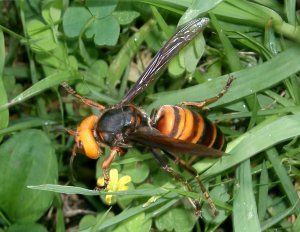
Take the Japanese giant hornet, as an example. The creepy critter we’re talking about, called the Vespa mandarinia japonica, is a subspecies of the Asian giant hornet. It is a very large insect that, once fully grown, can measure in at over 4 cm (1.6 in), or 6 cm (2.4 in) if we include wingspan. The creatures tend to have quite large yellow heads, with two giant fake eyes, followed by an additional three real eyes on their heads, which are substantially smaller. Underneath, their bellies have yellow and brown stripes, with a dark brown thorax.
The Japanese giant hornets have a hierarchy, where workers struggle to find food for their siblings. The menu usually includes anything from smaller insects to crop pests (something that is considered beneficial). The workers have a quite tough job, though. Once they kill their prey, they dismember it, and bring only the good stuff full of nutrients to the nest, like flight muscles. The workers and the larvae feed each other: the workers chew the prey they bring to the nest into paste that they feed to larvae which, after eating, produce a liquid (vespa amino acid mixture or VAAM), on which the workers feed. As cheap as the workers’ nourishment might sound, the fluid the larvae produce for them is very energetic as it allows intensive muscle work over extended periods of time. Thanks to the VAAM, giant hornets can fly up to a hundred kilometers per day (62 miles) and reach speeds of 40km/h (25 mph).
Japanese giant hornets are cool and everything, but the problem is they eat bees. Specifically, European honey bees, who we are currently facing a shortage of. When a giant hornet locates a hive of European honey bees, they leave pheromones (chemical substances secreted to generate a social response from the other members of the species) there in order to attract their friends to kill everybody there. As childish as an attack like this may seem, a single hornet is able to kill forty European honey bees in a minute, which makes a group of 30 hornets able to destroy an entire 30,000-bee hive in about three hours. The hornets won’t just kill the bees, they will also dismember them and return to the nest with them to feed the larvae. Heads and limbs are left in the combat zone. The hornets will also take the bee larvae to feed their own larvae and they even eat the bees’ honey.
For those of you who like some action, here is a short video of 30 hornets killing 30,000 bees.

Japanese honey producers prefer European honey bees because of their great honey productivity, but as you just read above, European honey bees don’t fare very well in Japan. Japanese honey bees, however, have a better protection system which makes them less vulnerable to the hornets and probably compensates for their lower honey productivity. When a giant hornet approaches a Japanese honey bee hive, all the bees go back to the hive and hide. Once the hornet is inside, they emerge from their hiding place, creating a cloud of about 500 bees around the hornet. All the Japanese honey bees tighten up in a ball around the hornet, creating a sort of fan oven with their wings’ vibration that pushes air over their bodies that is being warmed up by their muscles. The center of the ball will reach a temperature of 47°C (117°F) and the hornet, who cannot survive temperatures above 46° C (115°F), will die. The bees will live because they can survive temperatures up to 50°C (122°F).
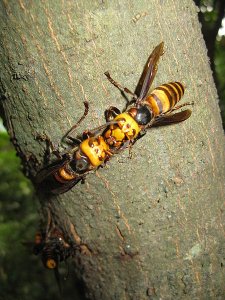
Japanese giant hornets also are venomous. Their stinger is about 6.25 mm (0.25 in) long and damages the tissues of the victims while attacking their nervous system. Testing in mice has revealed that the venom has an intravenous LD50 of 4.1 mg/kg, which isn’t so bad, compared with that of Vespa luctuosa venom in mice, which is 1.6 mg/kg. (LD50 stands for “lethal dose, 50%”; it is the median lethal dose, or the dose of a venom that will kill half the members of a population in a specific period of time. You can read more about LD50s and related topics here.) The Japanese giant hornet’s stings are extremely painful and victims may require hospital treatment. In Japan, hornets are known to be dangerous creatures, as they kill around 30 to 40 people every year.
To end this on a good note, Japanese hornets are known to be very fearful in spite of their big size. In addition, they aren’t aggressive, unless they feel threatened, of course. In Japan, fried hornets are known as a great delicacy!
Even though the Japanese giant hornet is the most common, and thus presents the most danger, there are many other little gifts of nature like the giant hornet in Japan. I know you would all like for the list of creepy Japanese insects to end here, but sadly, it doesn’t.
The Miniature Aragogs – The Joro and Huntsman Spiders

Image credit: Micha L. Rieser / Wikimedia Commons / CC-BY-3.0
Another reason to hide all your family and yourself is the Joro Spider, (Nephila clavata). Members of the golden silk orb-weaver genus, the Nephila clavata spends the winter in eggs and hatches in the spring. Females’ bodies measures from 17 to 25 mm (0.67 to 0.98 in), while the males’ bodies measure from 7 to 10 mm (0.26 to 0.39 in). If you did not guess when you saw its red, yellow and black jacket, the Joro spider is poisonous. If you get bit by one of these, it’s pretty much the same as getting bit by a black widow—not deadly, but not a kiss from Shirley Temple either. You’d be amazed knowing that this little dude over here has crept out the Japanese so badly it even has its place in Japanese folklore! Jorogumo is a spider that may change its appearance into that of a beautiful woman to seduce men and eat them!
Another sweetie you’ll meet in Japan is the hunstman spider. There really is much to say about the huntsman spider, but long story short, it’s huge—about 10 cm (4 in). The huntsman spider doesn’t hunt with webs like normal spiders. Ooooh no! That’s just too mainstream. The huntsman spider runs after its prey, catches it, beats it to the ground and tears it up to pieces for its next meal. Oh and did I mention it’s huge? I did, but I didn’t mention that they may grow up to a foot wide! For those who want nightmares, here’s a video on YouTube.
The only good news about the huntsman spider is that it’s not poisonous to humans. Phew! One thing less to worry about during your vacation in Japan—if you still decide to go after all this. (I love anime and all, but this really might be a deal breaker…)
The “Hide-Indoors” Giant Centipede
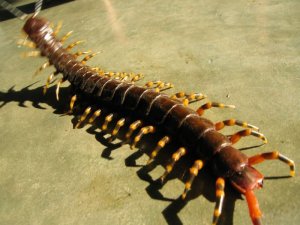
Next on our pretty list, we have the giant centipede (Scolopendra gigantea). Just hearing the name creeps you out, doesn’t it?
Personally, I don’t usually fear centipedes, but this one should be feared. Symbolizing evil in Japanese mythology, the giant centipede may grow up to 38 cm (15 in). This centipede is poisonous. If it bites you, you may have severe swelling, fever… anyway, it’s no fun. Usually, their poison is not fatal to humans (except to humans allergic to the toxins), but a really good bite may send you to the doctor. If you want to prove how brave you are, try climbing a tree or something (watch for spiders!) instead of showing off with these living nightmares.
The Japanese Mountain Leech

Next on the list is the Japanese mountain leech (Haemadipsa zeylanica). Leeches are never a good thing, except maybe for sucking demons out of annoying ten year olds. Most people find those nasty little creatures in the water, but the Japanese mountain leech is evolved: it does its business very comfortably on land!
Japanese mountain leeches, as harmless as they may seem, are quite clever evil geniuses: They can somersault after you at quite high speeds, and if that isn’t enough, they can climb trees to fall on you! And they hide in your shoes. They are equipped with a sucker at one end to move and suck their victims’ blood. On the other end, they have a very powerful jaw (they may have two or three of them) with thousands of small teeth which inject an anti-coagulant and a numbing compound into your blood to suck the life out of you. Plus, they have five pairs of eyes, so it doesn’t really matter where you are and what you do—our little friends here see you very well. Oh and by the way, they can get through your clothes, so if you think dressing like an Inuit will help you much, you’re wrong. It won’t.
Cockroaches 2.0 – Periplaneta Japonica
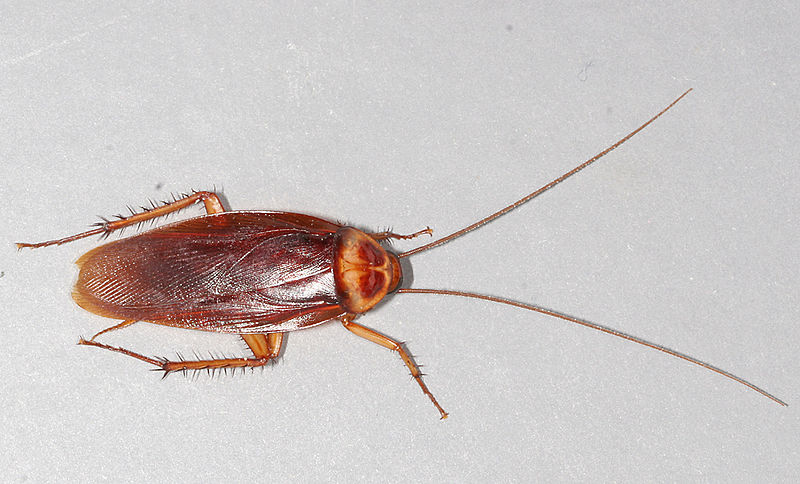
In addition to these marvellous little devils, Japanese cockroaches (Periplaneta japonica) are also super common in Japan. I probably don’t need to tell you much about these guys as just hearing the name must creep you out. But as we came here to learn, I must say that these cockroaches carry 33 types of bacteria: six parasites and seven pathogens (that we know of). They measure from 25 to 35 mm (0.98 to 1.38 in) once they reach maturity. They usually live outdoors, but they’re also just fine living indoors where there is food. The Japanese cockroach may go up to 45 minutes without breathing, live a month without food, and content itself with glue from a postage stamp. Talk about great survival skills!
The Caterpie – Not Pokémon *spoilers*
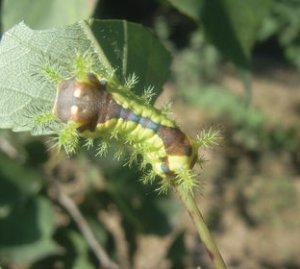
Go Caterpie go! Yes, you read it right, Caterpie does exist in Japan. The only difference is that Caterpie from Pokémon is always cute, and the real one stops being cute once you touch it.
Touch one of these cuties and you’ll feel as if you stuck a pair of scissors in an electric socket. These caterpillars don’t have electric powers like real Pokémon, but the chemicals they release, it has been told, feel very similar to an electric shock which is why they are nicknamed denkimushi (電気虫, “electric bug”). Properly named Monema flavcesens, this very unique type of caterpillar is about 25 mm long and belongs to the Limacodidae family. Long story short, with its extremely strong toxophores, this little Caterpie is as sweet as a cactus.
The Brown Marmorated Stink Bug

As you’ve noticed, Japan has very special and colourful fauna. All the beauty of it doesn’t end here! Meet the brown marmorated stink bug, or BMSB (Halyomorpha halys). The guys from Twilight would feel some sympathy for this little lad here as the stink bug sucks fluids out of vegetables with its little straw-like appendage called proboscis. They usually leave humans alone, but if you decide to bother them, be ready to leave covered in a cilantro-like odor. If you don’t want to walk home smelling worse than a dirty ogre, leave the thing alone.
The Cicadas – Just Loads of Summer Fun
![Cicada_molting_animated-2[1]](https://futurism.com/wp-content/uploads/2014/01/Cicada_molting_animated-21.gif?strip=all&quality=85)
Last but not least, we have cicadas (members of the family Cicadidae), another creepy yet important part of the Japanese wildlife. Cicadas have lots of history behind them. They are the symbol of summertime in Japan, and are so important that their sounds are often played in the background of Japanese movies and referred to in works of literature. Besides being famous in Japan, they are known all over the world. A great example of that would be La Fontaine’s fable ”La Cigale et la Fourmi” (“The Cicada and the Ant”). Long story short, some people love them, others hate them, but still, you have to admit, they’re quite creepy. Before they become tree bugs, cicadas live underground as nymphs and once they begin arguing with their parents when they hit puberty, they get out of the ground and find a nearby place to build a nest and leave their exoskeletons there for their children to collect. (So similar to humans, huh?)
Groups of cicadas may generate sound up to 120 dB (which is very loud). Aside from that that, they are harmless, except maybe if you look like a tree, they might climb on you and try to lay eggs on you and try to eat from you. Basically, these are the most harmless insects from the list. Set aside their appearance, the last creepy thing about them is that they die great numbers, so they drop dead from trees like sakura blossoms in the summer; a very pleasant sight.